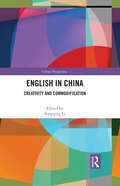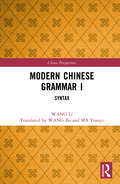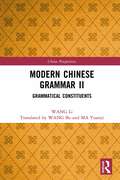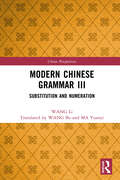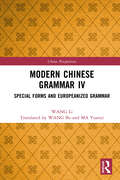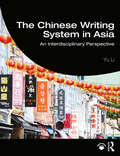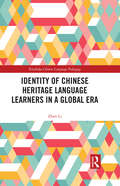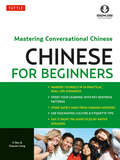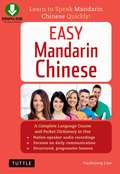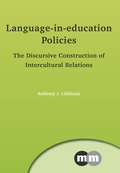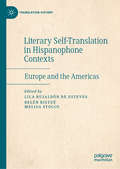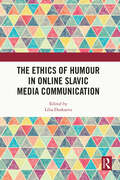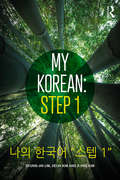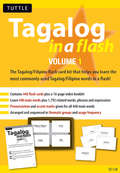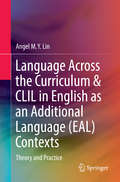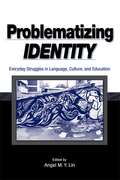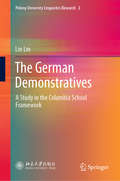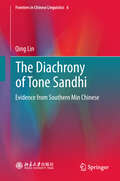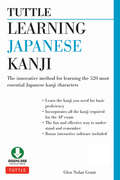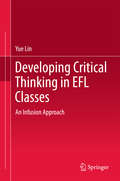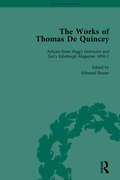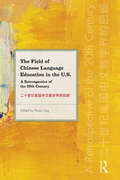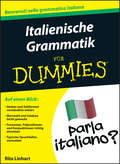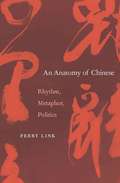- Table View
- List View
English in China: Creativity and Commodification (China Perspectives)
by Songqing LiEnglish-related linguistic creativity and language commodification are a constant topic of interest and analysis for scholars. This volume is intended to initiate a dialogue between these two domains of inquiry that have been abundantly addressed but rarely documented together or in relation to one another. English as used in mainland China is presented as a case study where it remains rather unclear the extent to which the language is actually used in people’s lives, outside the domain of education. The volume enriches existing empirical studies by exploring the creative and innovative uses of English in people’s lives and its commodification at different language-centred economic spaces within China while also providing an update of our understanding of the sociolinguistic situation of English in China, a country undergoing rapid socio-economic transformation. English in China is the first attempt to discuss the possible relationship, intersection, and tension between two seemingly inseparable research topics. The book is an important resource for students and scholars in the fields of Applied Linguistics, Bilingualism, Sociolinguistics, Translation, and Contemporary Chinese Studies.
Modern Chinese Grammar I: Syntax (China Perspectives)
by WANG LiFocusing on the fundamental grammatical units and construction in modern Chinese, this title is the first volume of a classic on modern Chinese grammar by WANG Li, one of the most distinguished Chinese linguists. Based on the corpus of two classic Chinese novels and being part of a four-volume set that describes the various linguistic patterns of modern Chinese grammar, this volume first distinguishes Chinese characters from words, categorizes words into different word classes and discusses the different word classes according to the number of syllables. The complex structures, which include phrases, sentences and various grammatical constructions such as those of optative, causative, disposal, passive, annex and retrenched, are then classified and elaborated on. Drawing on Otto Jespersen’s theory, the author applies the notion of rank to construct a new framework for Chinese grammar. Including a wide variety of examples and analyses, this book is a must-read for Chinese language learners, as well as researchers and students studying Chinese linguistics and modern Chinese grammar.
Modern Chinese Grammar II: Grammatical Constituents (China Perspectives)
by WANG LiFocusing on the fundamental grammatical units and construction in modern Chinese, this title is the second volume of a classic on modern Chinese grammar by WANG Li, one of the most distinguished Chinese linguists. This volume discusses nine major grammatical components in modern Chinese: 1) copulas, 2) negation, 3) adverbs, 4) markers applied to indicate the features of words or phrases, 5) aspects that indicate the duration and status of events, 6) moods that help express the emotions in language, 7) modal tertiaries, 8) connectives and 9) relative tertiaries. Including a wide variety of examples and analyses, this book is a must-read for Chinese language learners, as well as researchers and students studying Chinese linguistics and modern Chinese grammar.
Modern Chinese Grammar III: Substitution and Numeration (China Perspectives)
by WANG LiFocusing on substitution and numeration of modern Chinese, this is the third volume of a classic on modern Chinese grammar by WANG Li, one of the most distinguished Chinese linguists. In this volume, the author first introduces the different types of pronoun, such as personal pronoun, indefinite pronoun, resumptive pronoun, demonstrative pronoun and interrogative pronoun. Methods of numeration in modern Chinese are then delineated, encompassing such perspectives as cardinal number, ordinal number and numeration system of person, thing and behavior. Including a wide variety of examples and analyses, this book is a must-read for Chinese language learners, as well as researchers and students studying Chinese linguistics and modern Chinese grammar.
Modern Chinese Grammar IV: Special Forms and Europeanized Grammar (China Perspectives)
by WANG LiFocusing on the special forms and Europeanized grammar of modern Chinese, this is the final volume of a classic on modern Chinese grammar by WANG Li, one of the most distinguished Chinese linguists. This volume deals with the special forms in modern Chinese grammar, covering topics such as 1) reduplicated syllable, reduplicated words and opposite term, 2) incorporation, combination and idiom, 3) onomatopoeia and scene-painting, 4) repetition, 5) continuation and omission, 6) inversion and parenthesis and 7) interjection. The latter part of the volume concentrates on the changes in modern Chinese grammar resulting from the influence of Western languages, with the following aspects of Europeanized grammar being explored: 1) the coinage of disyllabic words, 2) the increase of subjects and copulas, 3) the extension of sentence lengths, 4) the Europeanization of potential forms, passive forms, markers and connective constituents and 5) new methods of substitution and numeration. Including a wide variety of examples and analyses, this book is a must-read for Chinese language learners, as well as researchers and students studying Chinese linguistics and modern Chinese grammar.
The Chinese Writing System in Asia: An Interdisciplinary Perspective
by Yu LiThe Chinese Writing System in Asia: An Interdisciplinary Perspective integrates a diverse range of disciplinary approaches in examining how the Chinese script represents and actively shapes personal and social identities in and beyond Asia. It is an ideal read for students and scholars interested in a broad and culturally rich introduction to research on the Chinese writing system. It can also serve as the main text of an undergraduate course on the subject. Key features of this volume include: Insights from studies of the Chinese writing system in linguistics, script reform and technology, gender, identity, literature, and the visual arts; Examples embedded in inquiries of the cultural history and contemporary society of Asia; Rigorous yet accessible discussions of complex concepts and phenomena that assume no prior knowledge of Asian languages or linguistics; Supplementary multimedia materials and resources, including instructional support, available online.
Identity of Chinese Heritage Language Learners in a Global Era (Routledge Chinese Language Pedagogy)
by Zhen LiIdentity of Chinese Heritage Language Learners in a Global Era enriches the current research on heritage language (HL) learner identity by examining how identity is constructed, negotiated, and performed in the narratives of university Chinese HL (CHL) learners in Hong Kong. This monograph has identified three sub-categories of CHL learners: domestic-born Chinese, ‘third culture’ Chinese, and overseas Chinese sojourners. Through systematically examining these CHL learners’ life-history narratives about language learning, language use, and social experiences from early childhood to university time, this monograph shows how CHL learner identity is dynamically constructed and changed through self and social positioning across a wide range of spatio-temporal contexts. It also adopts investment, agency, and imagined communities to examine the shared discourses which reflect the relationship between identity and the larger social processes that involve transnational or postcolonial encounters. This monograph contributes to reflections on the emerging discourses of HL learner identity in the context of multilingualism and transnational migration. It challenges the stigmatised image of CHL learners as ‘diasporic subjects’ or ‘language minority students’ in the literature and conceptualises CHL learners as transformative linguistic and social actors in processes of transnational migration and institutional change. This monograph is targeted toward educators, researchers, and professionals working in the fields of heritage language, overseas Chinese studies, migrant studies, and intercultural studies.
Chinese for Beginners
by Xiayuan Liang Yi RenThis is an excellent, user-friendly textbook for learning Chinese.Yi Ren has taught thousands of Americans to speak Chinese fluently. Now, she and co-author Xiayuan Liang share their secrets for fast mastery of Mandarin Chinese with you. China has 1.3 billion people and due to initiatives to phase out regional dialects in favor of Mandarin Chinese, nearly all of them can communicate in Mandarin. Don't let yourself be intimidated by this rewarding language. Although it is true that mastery of the Chinese language takes time, Mandarin Chinese actually has simpler grammar than English and there are no conjugations-meaning anyone can learn a few important phrases in no time. Chock full of extra hints and tips drawn from the authors' many years of experience teaching Mandarin Chinese in adult evening classes, Chinese for Beginners focuses on realistic situations you'll encounter when you meet people in China. New words are explained in terms of how you'll actually use them to communicate with new friends. The audio-CD lets you listen and repeat and remember the sentences with ease, and will help you soon declare with pride, "I can say that in Chinese!"Chinese for Beginners includes: Lighthearted approaches that bring Chinese to life in a down-to-earth fashion. Real-life dialogues and situations to help you converse with confidence . An "Extend Your Vocabulary" feature in each chapter helps you to remember and understand more words that you'd think possible . Native-speaker audio recordings teach you to pronounce Chinese tones accurately. Answer Keys help you keep track of your learning process . Interesting notes, idioms, sayings, photos, poems, and insider tips about China's culture, special places, and everyday life add to the adventure.This user-friendly guide to learning the basics will work for anyone who wants to speak and understand Chinese for business, for pleasure, or for travel-and who wants to enjoy the process of learning a new language while they're at it!
Chinese for Beginners
by Xiayuan Liang Yi RenThis is an excellent, user-friendly textbook for learning Chinese.Yi Ren has taught thousands of Americans to speak Chinese fluently. Now, she and co-author Xiayuan Liang share their secrets for fast mastery of Mandarin Chinese with you. China has 1.3 billion people and due to initiatives to phase out regional dialects in favor of Mandarin Chinese, nearly all of them can communicate in Mandarin. Don't let yourself be intimidated by this rewarding language. Although it is true that mastery of the Chinese language takes time, Mandarin Chinese actually has simpler grammar than English and there are no conjugations--meaning anyone can learn a few important phrases in no time. Chock full of extra hints and tips drawn from the authors' many years of experience teaching Mandarin Chinese in adult evening classes, Chinese for Beginners focuses on realistic situations you'll encounter when you meet people in China. New words are explained in terms of how you'll actually use them to communicate with new friends. The audio-CD lets you listen and repeat and remember the sentences with ease, and will help you soon declare with pride, "I can say that in Chinese!"Chinese for Beginners includes: Lighthearted approaches that bring Chinese to life in a down-to-earth fashion. Real-life dialogues and situations to help you converse with confidence . An "Extend Your Vocabulary" feature in each chapter helps you to remember and understand more words that you'd think possible . Native-speaker audio recordings teach you to pronounce Chinese tones accurately. Answer Keys help you keep track of your learning process . Interesting notes, idioms, sayings, photos, poems, and insider tips about China's culture, special places, and everyday life add to the adventure.This user-friendly guide to learning the basics will work for anyone who wants to speak and understand Chinese for business, for pleasure, or for travel--and who wants to enjoy the process of learning a new language while they're at it!
Easy Mandarin Chinese: Learn to Speak Mandarin Chinese Quickly! (Downloadable Audio Included)
by Haohsiang LiaoConcise and user-friendly, Easy Mandarin Chinese is designed for anyone who wants to learn Mandarin Chinese--whether on their own or with a teacher.This language learning book introduces the learner to all the basics of the Chinese language and teaches practical daily conversations and vocabulary. It enables users to begin communicating effectively from the very first day and it's compact size makes it a great tool for travelers or business people looking to learn Chinese on the road without giving up on any content.This Mandarin language learning book includes: Useful notes on the Chinese script, pronunciation, sentence structure, vocabulary, and grammar Sections covering greetings, requests, idiomatic expressions and common situations Cultural information about Chinese etiquette as well as do's and don'ts A glossary of the most commonly-used Mandarin Chinese words and phrases Downloadable audio with many hours of native-speaker recordings of the dialogues, vocabulary and exercises.
Language-in-education Policies
by Anthony J. LiddicoatThis book examines the ideological underpinnings of language-in-education policies that explicitly focus on adding a new language to the learners' existing repertoire. It examines policies for foreign languages, immigrant languages, indigenous languages and external language spread. Each of these contexts provides for different possible relationships between the language learner and the target language group and shows how in different polities different understandings influence how policy is designed. The book develops a theoretical account of language policies as discursive constructions of ideological positions and explicates how ideologies are developed through an examination of case studies from a range of countries. Each chapter in this book takes the form of a series of three in-depth case studies in which policies relating to a particular area of language-in-education policy are examined. Each case examines the language of policy texts from a critical perspective to deconstruct how intercultural relationships are projected.
Literary Self-Translation in Hispanophone Contexts - La autotraducción literaria en contextos de habla hispana: Europe and the Americas - Europa y América (Translation History)
by Lila Bujaldón de Esteves Belén Bistué Melisa StoccoThis edited book contributes to the growing field of self-translation studies by exploring the diversity of roles the practice has in Spanish-speaking contexts of production on both sides of the Atlantic. Part I surveys the presence of self-translation in contemporary Indigenous literatures in Spanish America, with a focus on Mexico and the Mapuche poetry of Chile and Argentina. Part II proposes to incorporate self-translation into the history of Spanish-American literatures- including its relation with colonial multilingual-translation practices, the transfers it allowed between the French and Spanish-American avant-gardes, and the insertion it offered for exiled Republicans in Mexico. Part III develops new reflections on the Iberian realm: on the choice between self and allograph translation Basque writers must face, a new category in Xosé Dasilva’s typology, based on the Galician context, and the need to expand the analysis of directionality in Catalan self-translations. This book brings together contributions from some of the leading international experts in translation and self-translation, and it will be of interest to scholars and students in the fields of Translation Studies, Cultural Studies, Comparative Literature, Spanish Literature, Spanish American and Latin American Literature, and Amerindian Literatures.
The Ethics of Humour in Online Slavic Media Communication
by Duskaeva LiliaThe Ethics of Humour in Online Slavic Media Communication is devoted to research on how the rules of humour used online media are changing and how these changes rearrange the traditions of speech interaction in media communication. The authors of the book are experienced researchers in the field of Slavic media linguistics and represent five neighbouring countries: Russia, Belarus, Lithuania, Slovakia, and Poland. The research in the volume is based on the data from Slavic languages. The diversity and, at the same time, relative proximity of Slavic languages makes it possible to put separate studies into a wider comparative context, in order to reveal the general and ethno-cultural patterns in using means of communicative etiquette; it helps define the ethno-cultural factors behind the formation of such means. Speech practice of humour creation shows the creative potential of all languages, including the ones with a small number of speakers – Slovak and Belarusian, which have the status of state languages, but are strongly influenced by international languages (English and Russian). This volume is a valuable resource for researchers in the field of Slavic studies.
My Korean: 나의 한국어 “스텝 1”
by Byung-jin Lim Jieun Kim Ji-Hye KimThe My Korean series of textbooks offers a learner-centred, communicative task-based, interactive approach to learning contemporary Korean. My Korean: Step 1 and My Korean: Step 2 are arranged thematically around topics that any novice learner of Korean is likely to encounter in their first year of study. Each lesson contains two dialogues showing contemporary Korean in use, followed by succinct grammar and vocabulary explanations. The focus throughout the books is on communicative in-class activities and tasks that encourage students’ active participation. Video clips of the lesson dialogues are available as an online resource, and each unit contains communicative activities based on the dialogue themes. The engaging structure and communicative approach make My Korean: Step 1 an ideal text for first semester Korean courses. It is also a great resource for individual study or one-on-one tutorials on Korean language and culture.
Tagalog in a Flash Volume 1
by Edwin LimTagalog in a Flash: Volume I is an excellent new language learning resource for beginning students of Tagalog.Tagalog is the national language of the Philippines, and the beloved language of the second-largest Asian-American ethnic group.<P><P>With a full range of features to help beginners and intermediate learners, Tagalog in a Flash Volume 1 is an excellent learning tool for anyone who wants to master Tagalog (also known as Filipino). Containing 448 flash cards of the most commonly used Tagalog words and phrases, along with sample sentences, handy indexes and a guide to using the cards for most effective learning, Tagalog in a Flash Volume 1 delivers.Contains 448 flash cars plus a 16 page index booklet.Learn 448 main words plus 1,792 related words, phrases and expressions.Pronunciation and accent marks given for all 448 main words.Arranged and sequenced in thematic groups and usage frequency.
Language Across the Curriculum & CLIL in English as an Additional Language (EAL) Contexts
by Angel M. Y. LinThis book will be of interest to a broad readership, regardless of whether they have a background in sociolinguistics, functional linguistics or genre theories. It presents an accessible "meta-language" (i. e. a language for talking about language) that is workable and usable for teachers and researchers from both language and content backgrounds, thus facilitating collaboration across content and language subject panels. Chapters 1 to 3 lay the theoretical foundation of this common meta-language by critically reviewing, systematically presenting and integrating key theoretical resources for teachers and researchers in this field. In turn, Chapters 4 to 7 focus on issues in pedagogy and assessment, and on school-based approaches to LAC and CLIL, drawing on both research studies and the experiences of front-line teachers and school administrators. Chapter 8 provides a critical and reflexive angle on the field by asking difficult questions regarding how LAC and CLIL are often situated in contexts characterized by inequality of access to the linguistic and cultural capitals, where the local languages of the students are usually neglected or viewed unfavourably in relation to the L2 in mainstream society, and where teachers are usually positioned as recipients of knowledge rather than makers of knowledge. In closing, Chapter 9 reviews the state of the art in the field and proposes directions for future inquiry.
Problematizing Identity: Everyday Struggles in Language, Culture, and Education
by Angel M. Y. LinThis book argues that identity as a term needs to be problematized, not taken for granted � for both the risks and the potential that the concept offers to educators for understanding issues of social inequality and how social inequality is being reproduced, and for exploring possible alternative ways educators can work with identity de/formation p
The German Demonstratives: A Study in the Columbia School Framework (Peking University Linguistics Research #2)
by Lin LinThis book explores, analyzes, and compares the use of German and Chinese demonstratives. Discourse and textual uses of the forms are considered, as well as their locative and temporal uses. The author observes that in both languages the demonstratives can be used to refer to referents. However, she departs from the common assumption that proximal demonstratives refer to entities or places close to the speaker, while non-proximal demonstratives refer to entities or places far from the speaker. Having analyzed a representative sampling consisting of a German text and a Chinese text, the author argues that both German and Chinese proximal demonstratives can signal the meaning of HIGH DEIXIS in a system of DEIXIS in the Columbia School of linguistics framework, whereas their non-proximal demonstratives can signal the meaning of LOW DEIXIS. In addition, Chinese demonstratives can be used under more circumstances than German demonstratives due to the lack of articles in Chinese. The author also argues that Cognitive Linguistic analysis is more helpful for new language learners, whereas the Columbia School of linguistics may be better suited to advanced learners who wish to know more about the intrinsic differences between words with similar meanings and uses.This book aims to help German learners better understand the German reference system. Readers with a Chinese language background will definitely benefit more from the book, as well as Chinese learners with a German language background. For pure linguistic enthusiasts and multi-linguals, the book offers an extensive introduction to the Columbia School of linguistics, and can open a new horizon for learning a new language comparatively.
The Diachrony of Tone Sandhi: Evidence from Southern Min Chinese (Frontiers in Chinese Linguistics #6)
by Qing LinThis book investigates the diachronic change of the tone sandhi of Southern Min Chinese, which is known for its synchronic arbitrariness and opacity. It argues that in final-prominent tone sandhi, the change of final tones and the change of non-final tones can be highly independent and essentially different from each other. Accordingly, it proposes a new position-based diachronic approach to study the separate evolution of tones occurring at different positions. This book is the first study to rigorously and systematically explore the diachrony of Southern Min tone sandhi.
Tuttle Learning Japanese Kanji: The Innovative Method for Learning the 500 Most Essential Japanese Kanji Characters
by Ya-Wei Lin Glen Nolan GrantThis book enables you to easily recognize the 500 most essential Japanese Kanji-and to memorize their readings and meanings quickly and easily!<P><P> This book teaches an innovative new method to learn the basic 500 Japanese characters-teaching you how to easily recognize the Kanji and to remember their readings and meanings. Learning to read Japanese and write Japanese requires knowing hundreds of Kanji. Traditionally, the ability to learn Kanji characters was accomplished purely by rote memorization. This method is extremely slow, tedious and time-consuming. The new science of mnemonics has changed all that. By associating an easily-remembered visual image and story with each Kanji, the learner is able to commit the characters to long-term memory far more easily and quickly than ever before. mnemonics also dramatically helps students to write kanji as well. This revolutionary new method has been tried by many thousands of students and it really works!Using a systematic building-block approach to written Japanese, this beginner kanji book also shows you how more complicated characters are constructed from simpler elements. And similar mnemonic strategies are provided for learning the different pronunciations or "readings" of the characters.This book can be used by anyone, and requires no prior knowledge of the Japanese language. It can be used in conjunction with any Japanese textbook to learn the important Kanji characters upon which the language is based.Key features of this book include: Drawings and stories to create mental associations for the characters that stick in the brain and allow you to recall their meanings and readings. Downloadable material showing you how to write each kanji character Native speaker audio recordings for all the Kanji characters, vocabulary and sample sentences. Sample sentences to expand your vocabulary by showing you how the Kanji are actually used. Extensive review exercises to reinforce what you've learned. User-friendly indexes allowing you to look-up the Kanji and use the book like a Kanji dictionary.The 500 Kanji characters provided in this book include all the characters needed for the AP and JLPT Level 4 and 5 exams-giving you access to approximately 80 percent of all the Kanji characters you encounter in Japan!
Developing Critical Thinking in EFL Classes: An Infusion Approach
by Yue LinThis book presents an innovative teaching experiment and an analytical study of critical thinking and the sociocultural theory of learning to illustrate the cognitive learning development mechanisms. It addresses the issues in developing critical thinking, including the controversy surrounding the definition, measurement and teaching of critical thinking, particularly in the L2 context.The book explains how infusion-thinking lessons can be structured to help students develop critical thinking along with language learning. Further, it uses a case study as a real-world example to examine the applicability and feasibility of infusion-thinking lessons in the EFL context and their effectiveness in developing students’ critical thinking and language learning.Packed with thinking activities and techniques, this practical, hands-on manual provides original ideas and empirical data, giving teachers everything they need to plan their lessons to improve students’ critical thinking within language courses and evaluate their teaching.
The Works of Thomas De Quincey, Part III vol 17
by Grevel Lindop Barry SymondsThomas De Quincey (1785-1859) is considered one of the most important English prose writers of the early-19th century. This is the final part of a 21-volume set presenting De Quincey's work, also including previously unpublished material.
The Field of Chinese Language Education in the U.S.: A Retrospective of the 20th Century
by Vivian LingThis book will be the first account of the development of Chinese as a foreign language in the U.S., as it interacts with the relevant entities in China and beyond. There are virtually no systematic retrospective reflections on the field outside of the greater China region; and yet over the past decades the field has grown by leaps and bounds, and it is critical now that we pause to reflect on what has happened and what we can learn from the past. The contributors are among some of the most influential pioneers in the field whose entire academic lives have been dedicated to its development. The Field of Chinese Language Education in the U.S.: A Retrospective of the 20th Century is aimed at those who are currently engaged in Chinese language education, as teachers or as students.
Italienische Grammatik für Dummies (Für Dummies)
by Rita LinhartSteht der nächste Test an, haben Sie italienische Kollegen, mit denen Sie sich austauschen wollen, oder möchten Sie in Ihrem Italienurlaub mehr als einfach nur "Grazie" sagen können? Grammatik ist nicht jedermanns Sache und die italienische Grammatik macht es einem auch nicht immer leicht. Rita Linhart kennt die Nöte der Lernenden und die Fallen der italienischen Grammatik, in die sie häufig hineintappen. Leicht verständlich, mit einer Prise Humor und anhand vieler Beispiele und Informationen zu Land und Leuten erklärt sie alles über Artikel und Pronomen, Adjektive und Adverbien, Fragestellung und Verneinung, die Zeiten und die Satzstellung. Am Ende eines jeden Kapitels gibt es Übungen, die das Gelernte noch einmal wiederholen. Tabellen der wichtigsten italienischen Verben bieten ganz Eiligen alle Konjugationen auf einen Blick. So sind Sie für den nächsten Test gerüstet, können mit Ihren italienischen Kollegen über zukünftige Projekte sprechen oder einfach nur unbeschwert im Italienurlaub parlieren.
An Anatomy of Chinese
by Perry LinkRhythms, conceptual metaphors, and political language convey meanings of which Chinese speakers themselves may not be aware. Link’s Anatomy of Chinese contributes to the debate over whether language shapes thought or vice versa, and its comparison of English with Chinese lends support to theories that locate the origins of language in the brain.
